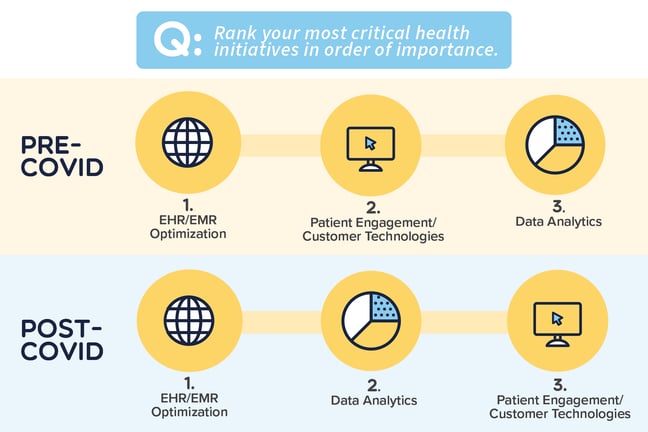CereCore recently discussed the results of a pre-quarantine CHIME CIO survey in this Healthcare IT News interview. In addition, feedback from the CereCore CIO Cohort and recent CHIME focus group has prompted us to re-rank the top three CIO priorities in our earlier survey.
The original survey results demonstrated the top priorities for healthcare CIOs as EHR/EMR Optimization (1), Patient Engagement Technologies (2), and Data Analytics (a close third). However, healthcare organizations were not able to provide real-time predictive information about the influx of patients or deal with supply chain challenges when the crisis struck. Each group was consistent in citing that improving data analytics had overtaken patient engagement in priority and that driving stronger analytics is essential to operating in a new normal.

While the group discussed that maximizing their largest investment, the EHR is still the highest priority, there are new contexts to consider when making decisions in moving their organizations forward. These new nuances to prior challenges include:
- EHR Optimization: CIOs are feeling the pressure to maximize adoption and efficiency while doing more with finite resources. This includes making the EHR as user-friendly as possible for caregivers, connecting health information for interoperability, and optimizing workflows for analytics and operational efficiency. CIOs cited concerns regarding cost and time pressures related to optimization projects as well as worries about dependence on special grants for these projects in a landscape of growing national debt.
- Analytics versus Patient Engagement (telehealth): Even though telehealth use exploded during the shutdown, managing additional cost pressures and the uncertainty of how telehealth reimbursements will be handled in the long-term were caused CIOs to downrank telehealth behind analytics. Most health systems were challenged to forecast cases or supply chain needs from predictive analytics and cited that stronger analytics had grown in importance for their organizations moving forward.
- Cybersecurity: Another priority that CIOs cited was new cybersecurity challenges. Not only are phishing and other schemes to gain health data more frequent, there are new considerations related to a distributed workforce, remote access, and related privacy issues that these new scenarios bring to bear.
- Sustaining a remote or hybrid workforce: Many CIOs are evaluating both the short and long-term impacts of a remote workforce. While cybersecurity and expanded network access are immediately critical, there are also opportunities in restructuring IT support for efficiency in this new model.
CIOs are transparent about facing a current lack of clarity regarding their financial situation going forward and are understandably holding back on major commitments. Zand offered a few suggestions in his Healthcare IT News interview:
- It is possible to build scalability and flexibility into their IT infrastructure. CIOs should evaluate managed services and project-based services in key areas to find savings in the “blocking and tackling” of IT maintenance and support in order to focus internal resources on strategic projects that deliver operational value.
- CIOs will benefit by placing a high focus on staying connected with the strategic objectives of the organization. However staying visible and connected can be more difficult in fully-remote situations.
- CIOs should reexamine their IT projects, vendor spend, and priorities in light of the strategic priorities of the organization.
For more insight and the full pre-shutdown survey results, click here.


